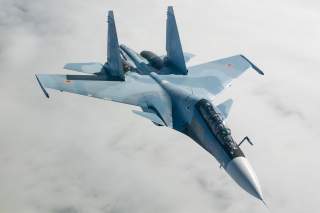Why China's Air Force Loves Russian SU-35 Fighters (And Keeps Getting More)
A great boon for China's air force.
You May Also Like: 5 Best Submarines of All Time, 5 Best Aircraft Carriers of All Time, 5 Best Battleships of All Time and Worst Submarine of All Time.
Key point: China is still looking to expand its logistical support fleet as it continues to modernize its air force.
For a nation that boasts of developing an advanced stealth fighter, it seems strange that China would need to buy warplanes from its former rival Russia.
Yet Moscow is offering to sell more Su-35 fighters to Beijing – and Chinese media reports that Beijing may accept.
China has already bought 24 Su-35s – an upgraded version of the Cold War Su-27 Flanker – in a 2015 sale worth $2.5 billion, according to Russian news agency TASS. “We are expecting a response from China on our offer to purchase modern weapons and military equipment manufactured in Russia, including additional batches of Su-35 fighter jets," Russia’s arms export agency told TASS last week.
Two days later, a Chinese military television channel reported that China may buy more Su-35s to replace older aircraft. China has about 3,000 aircraft – roughly the size of the U.S. Air Force – including 1,700 fighters. But many are obsolete Cold War planes, including several hundred Chinese copies of Russia’s 1960s-era MiG-21. Thus even as China fields the fifth-generation J-20 stealth fighter – ostensibly the counterpart of the American F-22 and F-35 – the People’s Liberation Army Air Force is saddled with the logistical challenges of maintaining a huge fleet of old planes.
Yet, China’s state-controlled Global Times newspaper also cited a Chinese military expert who believes there are other reasons to buy the Su-35. Fu Qianshao told the Global Times that “while China could indeed buy more Su-35s, they are not meant to replace older Chinese jets because the Russian aircraft is too expensive and China has too many old jets. The replacement will most likely be done by domestically made warplanes, he said.”
“Having already bought a batch of Su-35s previously, China does not need more to learn from it technically, Fu noted. But if China indeed buys more, it would make the Chinese Air Force's logistical support for the warplane fleet more efficient as there would be more spare parts and dedicated personnel, Fu said, noting that economic and political factors might also play a part in the potential deal due to China and Russia's close relations, and a Chinese purchase would help boost Russia's aviation industry.”
The Chinese analyst has a point: Global airpower has been trending away from the mass airfleets of World War II and the Cold War, in favor of smaller numbers of highly sophisticated and expensive warplanes. If Beijing only bought 24 Su-35s the first time around for $2.5 billion, then buying hundreds to replace the J-7 and J-8 fighters would be financially ruinous as well as numerical overkill. But interesting is the suggestion that an Su-35 purchase would support the aviation industry of Russia, a nation with a stagnant economy but a strong military research and manufacturing capability.
Still, given Beijing’s pride in its growing military and economic strength, and its ability to develop advanced weapons such as stealth fighters, it seems surprising that China must import warplanes, jet engines, anti-aircraft missiles and other equipment. China’s GDP is about nine times larger than that of Russia (Britain also buys American warplanes, but Britain’s economy is one-eighth that of America’s).
For now, it may indeed make sense for China to buy fighters from Russia: the two nations, which once fought a border war and vied for supremacy in the Communist bloc, now enjoy friendly – but wary – relations. But given its ambitions, at some point China will have to rely on its own resources.
Michael Peck is a contributing writer for the National Interest. He can be found on Twitter and Facebook. (This article first appeared in early 2019 and is being republished due to reader interest.)
Image: Wikimedia.

